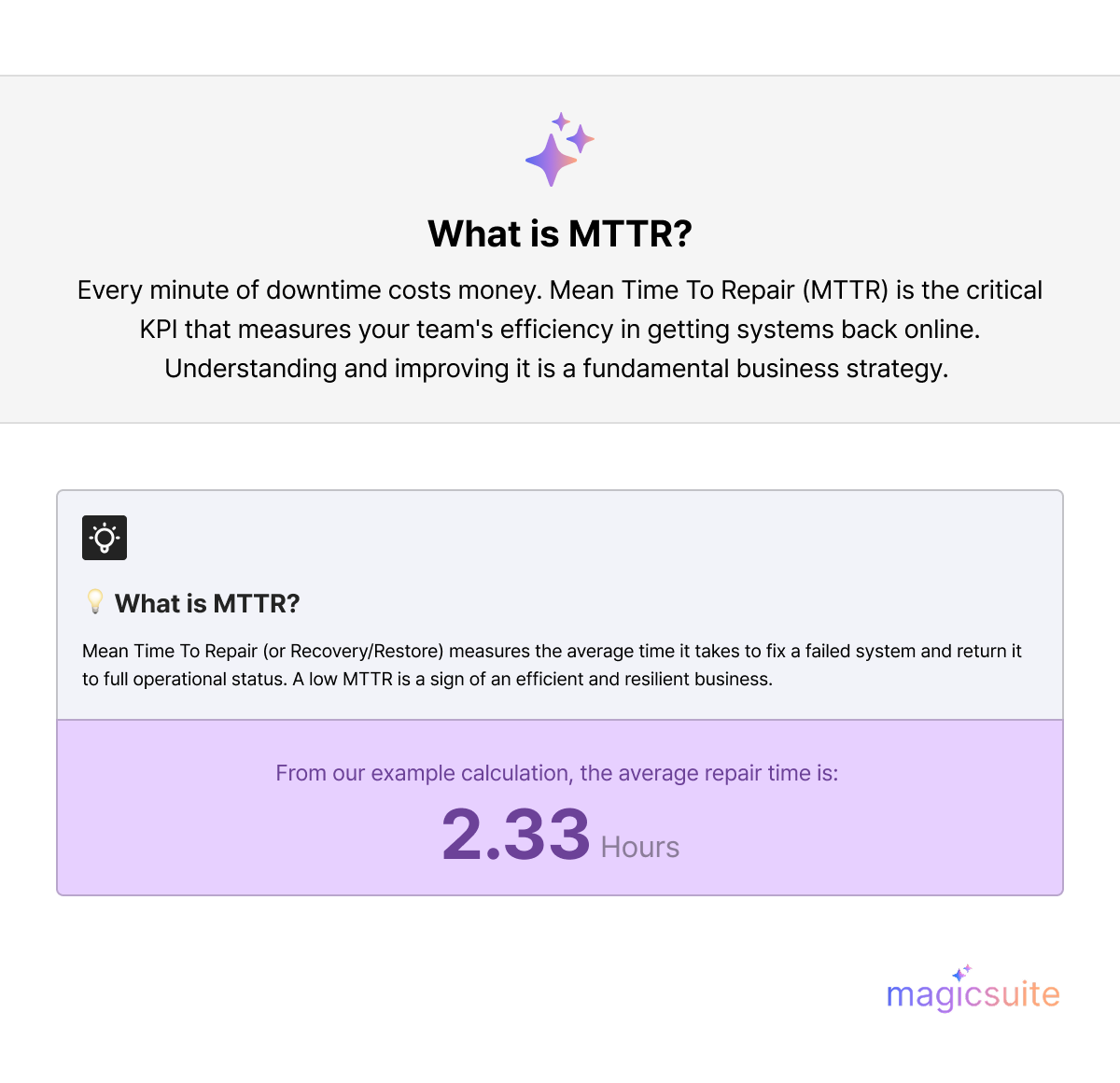Learn what MTTR is, how to calculate it, and why this key metric is essential for improving system reliability and reducing downtime in IT and business operations.

Downtime is a business’s worst enemy. Every minute a system is offline can lead to lost revenue, decreased productivity, and damaged customer trust. This is where MTTR, or Mean Time To Repair, becomes a critical metric. It's a key performance indicator (KPI) used to measure the efficiency of your maintenance and support teams.
Understanding, tracking, and actively improving your MTTR is not just an IT concern—it's a fundamental business strategy for reliability and resilience. This article will break down what MTTR is, how to calculate it, and why it’s one of the most important metrics you can track.
MTTR, which stands for Mean Time To Repair or Mean Time To Recovery, is a key performance indicator (KPI) that measures the average time it takes to repair a failed system or component and return it to full operational status.
It's a crucial metric for evaluating the efficiency of maintenance and support teams, especially in fields like IT, manufacturing, and engineering. A lower MTTR indicates a more efficient and effective repair process, leading to less downtime and greater productivity.

The core meaning of MTTR is simple: it quantifies the duration of a repair cycle. This cycle begins the moment a failure is detected or a maintenance team begins work on the issue and ends when the system is fully functional again. The calculation for MTTR includes all the time spent on the repair process, such as:
For an e-commerce website, this would be the total time from the first customer reporting a broken checkout page to the page being fully functional again for all users.
A "good" MTTR is relative and depends on the industry, the criticality of the system, and the complexity of the repairs. Generally, a lower MTTR is always better. For mission-critical systems, an MTTR of under an hour may be the goal, while for less critical systems, a few hours might be acceptable.
A low MTTR is a sign of a healthy, resilient business. It's a crucial metric for several reasons:

Calculating MTTR is a straightforward process. You sum up the total time spent on all repair incidents over a specific period and then divide that by the number of incidents.
The formula is: MTTR=Number of IncidentsTotal Downtime
Example: Imagine a web hosting company experiences three service outages over a month:
Using the formula, the MTTR for the month would be:(3.5+1.75+1.75)/3=7/3≈2.33 hours. In this scenario, the MTTR for the web hosting company is approximately 2.33 hours.
MTTR is often confused with other "Mean Time To" metrics. While they all measure different aspects of system reliability, each provides a unique insight.
Understanding the distinction between these metrics is vital for a comprehensive view of your system's performance and reliability.
Read more on Complete Guide to Ticket Resolution: Metrics & Best Practices
To reduce MTTR, you should focus on improving your repair process. Some strategies include:
In the end, a company's ability to quickly recover from a system failure is a direct measure of its operational maturity. By tracking and actively working to reduce your MTTR, you're not just improving a single metric; you're building a more resilient, cost-effective, and customer-centric organization. A low MTTR is a testament to an efficient team and robust systems, helping you minimize the impact of inevitable failures and keep your business running smoothly.
Ready to streamline your operations? Discover how to reduce downtime and improve your MTTR with the powerful tools from MagicSuite.ai. Explore MagicTalk today!

Hanna is an industry trend analyst dedicated to tracking the latest advancements and shifts in the market. With a strong background in research and forecasting, she identifies key patterns and emerging opportunities that drive business growth. Hanna’s work helps organizations stay ahead of the curve by providing data-driven insights into evolving industry landscapes.